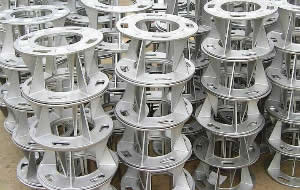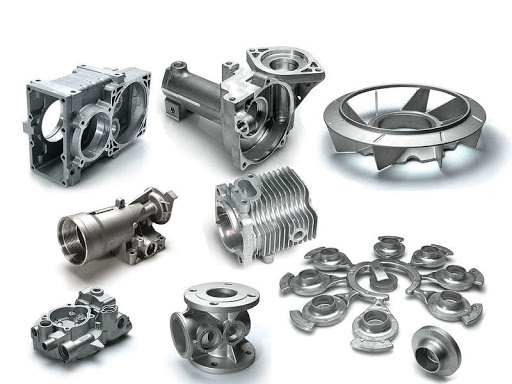The dedication of Wisconsin Aluminum Foundry to excellence
Revealing the Conveniences and Practical Utilizes of Aluminum Castings in Today's Market
Light weight aluminum castings have actually become increasingly appropriate in numerous industries due to their distinct attributes. Their lightweight nature and resistance to deterioration make them ideal for requiring applications. Furthermore, the superior strength-to-weight proportion uses substantial benefits in style and manufacturing. As industries remain to explore their capacity, the full range of light weight aluminum spreadings' applications and benefits stays to be fully revealed. What exists ahead for this versatile material?
The Lightweight Benefit of Aluminum Castings
Although numerous materials are utilized in production, light weight aluminum castings attract attention mostly because of their lightweight residential properties. This particular makes light weight aluminum castings an attractive choice for various markets, particularly in aerospace and automotive applications, where weight reduction is necessary for improving gas effectiveness and efficiency. The light-weight nature of light weight aluminum enables suppliers to produce elements that are much easier to install and deal with, eventually minimizing labor prices.
The capacity to create intricate forms without significant weight penalties enables developers to introduce while keeping architectural honesty. Light weight aluminum spreadings can successfully change much heavier materials, resulting in substantial financial savings in delivery and operational prices. Their light-weight benefit likewise adds to enhanced product durability, as lighter elements commonly result in decreased deterioration on equipment. Generally, the lightweight residential or commercial properties of aluminum spreadings provide suppliers with an one-upmanship, fostering developments in item layout and efficiency across different industries.

Phenomenal Rust Resistance
Light weight aluminum spreadings possess an all-natural resistance to oxidation, which greatly boosts their longevity in various atmospheres. This integral building not only contributes to their longevity but also lines up with the lightweight benefit that light weight aluminum supplies. Therefore, light weight aluminum castings are increasingly recognized for their exceptional rust resistance in many applications.

Naturally Resistant to Oxidation
Among the standout qualities of light weight aluminum spreadings is their exceptional rust resistance, which stems from an all-natural oxidation procedure. When exposed to air, light weight aluminum responds to create a thin, safety layer of aluminum oxide. This layer functions as a barrier against further oxidation and shields the underlying metal from destructive elements such as dampness and salts. Unlike various other metals, this oxide layer is self-repairing; if damaged, it rapidly reforms when subjected to air. This unique property enhances the durability of light weight aluminum spreadings in numerous atmospheres, making them ideal for applications in industries such as aerospace, auto, and marine. As a result, the natural resistance to oxidation considerably lowers upkeep expenses and enhances the dependability of aluminum spreadings sought after problems.
Lightweight Longevity Advantage
The lightweight nature of light weight aluminum spreadings contributes substantially to their sturdiness, making them an advantageous choice in numerous industries. This extraordinary sturdiness is mainly credited to aluminum's innate resistance to deterioration, which is boosted better with anodizing and various other surface treatments. Unlike many steels, aluminum does not rust; instead, it creates a protective oxide layer that shields it from environmental damages. This residential or commercial property is specifically valuable in industries such as vehicle and aerospace, where weight reduction is critical without jeopardizing strength. Additionally, the longevity of light weight aluminum spreadings lessens upkeep costs and substitutes, providing economic benefits over time. Their light-weight sturdiness and corrosion resistance setting aluminum castings as a premium product for modern production applications.

Superior Strength-to-Weight Ratio
A remarkable quality of aluminum spreadings is their superior strength-to-weight ratio, which makes them highly desirable in numerous applications. This inherent residential property enables light weight aluminum spreadings to stand up to significant stress and anxiety while staying light-weight, an essential consider industries such as aerospace, automotive, and manufacturing. Designers frequently choose aluminum spreadings for parts that require both toughness and reduced weight, boosting gas performance and efficiency.
The high strength-to-weight proportion also promotes the design of detailed forms and frameworks, making aluminum castings versatile for complex applications. In addition, the ability to preserve structural honesty under challenging problems warranties longevity and dependability in items, from airplane frameworks to vehicle parts. This benefit adds to the expanding pattern of making use of aluminum castings in innovative layouts, eventually causing enhanced capability and efficiency across diverse industries. As a result, the exceptional strength-to-weight ratio of aluminum spreadings positions them as a pivotal product in contemporary design and manufacturing.
Cost-Effectiveness in Production
Cost-effectiveness in light weight aluminum casting manufacturing is primarily attained with reduced material waste and efficient production processes. By enhancing designs and utilizing advanced strategies, manufacturers can minimize excess material use while keeping quality criteria. This technique not only decreases production prices yet likewise contributes to a lot more sustainable techniques within the market.
Minimized Product Waste
Lowering product waste in aluminum casting processes greatly boosts manufacturing effectiveness. By optimizing the layout and production strategies, business can decrease excess scrap and boost source application. This decrease in waste not only decreases material costs yet also adds to an extra sustainable production version. The capacity to reuse light weight aluminum additional assistances cost-effectiveness, allowing makers to redeem and reuse products without endangering quality. As the market significantly concentrates on sustainability, decreased product waste lines up with environmental goals while concurrently enhancing productivity. Inevitably, reliable use of basic materials reinforces the competitive placement of businesses on the market, making aluminum spreadings a favorable option in various applications. The critical method to decreasing waste reflects a commitment to both ecological from this source and financial obligation.
Efficient Production Processes
While traditional manufacturing processes can incur considerable expenses, light weight aluminum spreading provides an extra efficient choice that boosts overall manufacturing profitability. This technique decreases material waste and permits specific control over the production procedure, resulting in reduced labor and operational prices. The ability to generate complex forms with less actions further enhances manufacturing, adding to shorter lead times. In addition, light weight aluminum's lightweight nature and excellent thermal conductivity permit energy savings throughout manufacturing and in the final application. By using contemporary casting innovations, manufacturers can achieve greater throughput without giving up quality. Aluminum spreading stands out as a cost-efficient remedy, making it an attractive option for companies aiming to enhance their production procedures in today's affordable market.
Flexibility Across Industries
Light weight aluminum castings demonstrate remarkable convenience throughout different sectors, as they can be customized to satisfy details requirements and applications. In the automobile sector, aluminum spreadings are made use of in engine blocks, transmission housings, and wheels, using lightweight yet resilient remedies that enhance gas effectiveness. The aerospace industry also takes advantage of light weight aluminum spreadings, utilizing them in architectural parts and engine parts because of their strength-to-weight ratio.
In the customer items sector, makers utilize light weight aluminum castings for items ranging from cooking equipment to furnishings, supplying both visual allure and functionality. The electronics sector uses light weight aluminum castings for real estates and warmth sinks, making certain reliable thermal administration. In addition, the building and construction field leverages light weight aluminum spreadings for building components and architectural components, boosting durability and layout adaptability. This broad applicability highlights aluminum castings as an essential resource, satisfying the diverse requirements of numerous markets while preserving high performance and reliability.
Sustainability and Ecological Impact
As see post sectors increasingly focus on sustainable techniques, light weight aluminum castings become an environment-friendly choice as a result of their recyclability and reduced ecological footprint. Light weight aluminum is just one of the most recycled products around the world, with the capability to be repurposed several times without deterioration of high quality. This characteristic significantly minimizes the demand for basic materials and power intake related to main aluminum manufacturing, which is energy-intensive.
In addition, light weight aluminum spreadings add to light-weight styles, causing sustain performance in transportation applications such Visit Your URL as vehicle and aerospace industries. Their longevity and resistance to corrosion extend item lifespans, additionally reducing waste and resource use gradually. Numerous manufacturers are taking on liable sourcing and environmentally friendly manufacturing techniques, boosting the sustainability of aluminum casting procedures. Overall, aluminum castings represent a sensible remedy for services intending to lower their ecological effect while attaining performance and effectiveness.
Innovations in Aluminum Casting Technologies
Current developments in light weight aluminum spreading technologies have substantially improved the performance and top quality of production processes. Advancements such as 3D printing and progressed mold-making methods have actually enabled makers to develop elaborate styles with reduced material waste. This shift not just boosts the precision of actors elements but additionally shortens lead times, enabling fast prototyping and faster market access.
The consolidation of advanced computer simulations help in forecasting prospective flaws throughout casting, leading to higher-quality outcomes. Making use of light-weight alloys has actually likewise added to the advancement of more powerful, much more durable products, accommodating sectors varying from vehicle to aerospace
Furthermore, automated casting processes have actually arised, lessening human mistake and boosting production rate. Collectively, these technologies are changing the light weight aluminum spreading landscape, driving higher competitiveness and sustainability in production. As sectors continue to progress, these innovations will play a crucial function in conference future needs for performance and high quality.
Often Asked Concerns
How Do Light Weight Aluminum Castings Contrast to Other Metals in Regards To Thermal Conductivity?
Aluminum spreadings display remarkable thermal conductivity compared to several metals, such as steel and iron - Aluminum Foundry. Their light-weight nature and efficient warm circulation make them perfect for applications requiring efficient thermal monitoring in numerous industries
What Are the Common Problems Found in Light Weight Aluminum Castings?
Common problems in aluminum castings include porosity, shrinking, inclusions, and surface abnormalities. These problems commonly emerge from inappropriate cooling rates, insufficient mold design, or contaminations, affecting the general quality and performance of the last item.
Can Light Weight Aluminum Castings Be Recycled, and Just how?
Aluminum spreadings can be recycled efficiently. The process involves accumulating, melting, and reforming the aluminum, which lessens waste and saves resources. This reusing adds to sustainability while keeping the material's residential or commercial properties for future use.
What Are the Common Lead Times for Light Weight Aluminum Casting Manufacturing?
Usually, lead times for light weight aluminum casting production array from two to 6 weeks, depending on elements such as intricacy, tooling demands, and production quantity. Effectiveness can enhance with well established vendor relationships and maximized manufacturing procedures.
Exactly how Does the Surface Area End Up Affect Light Weight Aluminum Casting Performance?
The surface area finish noticeably affects aluminum casting performance by influencing deterioration resistance, aesthetic quality, and friction attributes. A smoother coating enhances resilience and capability, while a rougher texture can improve attachment for subsequent coatings or therapies.
Many products are used in production, light weight aluminum spreadings stand out largely due to their light-weight residential or commercial properties. When subjected to air, aluminum reacts to create a slim, safety layer of light weight aluminum oxide. Cost-effectiveness in light weight aluminum casting production is mainly attained via decreased material waste and efficient manufacturing procedures. Reducing material waste in aluminum spreading procedures greatly enhances production effectiveness. Eventually, efficient usage of raw materials strengthens the competitive setting of businesses in the market, making light weight aluminum castings a beneficial option in various applications.